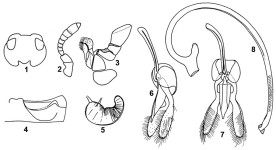Scientific name
Curinus coeruleus (Mulsant)
Taxonomic position
Coleoptera: Coccinellidae: Chilocorinae: Chilocorini
Diagnosis
Length 4.90-5.20 mm, width 4.50-4.75 mm. Form round in male, broad oval in female, hemispherical and strongly convex. Head orange yellow in male and dark pitchy brown to black in female. Pronotum dark purplish blue in middle, anterolateral flanks bright orange yellow. Elytra uniformly dark
metallic purplish blue. Ventral side orange yellow except median part of prosternum, meso- and metasterna dark brown to black; elytral epipleura darker. Abdomen with five and six visible segments in female and male, respectively; fifth medially deeply emarginate in male and narrowly arcuate in female. Male
genitalia (Figs 6-8) and female spermatheca (Fig. 5) as illustrated.
 Figs. 1-8. Curinus coeruleus: 1. Head; 2. Antenna; 3. Maxilla; 4. Postcoxal line on abdominal ventrite I; 5. Female spermatheca; 6-7. Male genitalia: 6. Tegmen, lateral view; 7. Tegmen, ventral view; 8. Sipho Figs. 1-8. Curinus coeruleus: 1. Head; 2. Antenna; 3. Maxilla; 4. Postcoxal line on abdominal ventrite I; 5. Female spermatheca; 6-7. Male genitalia: 6. Tegmen, lateral view; 7. Tegmen, ventral view; 8. Sipho
Images
Distribution
It is a native of South America and was introduced in India from Thailand in 1988 (Jalali & Singh, 1989) and also in Indonesia, Hawaii, and the Philippines, for controlling subabul psyllid, Heteropsylla cubana Crawford. It has permanently established in all the subabul growing regions of the country, mainly in southern India. Recorded as an adventive species in Florida, USA.
Prey / Associated habitat
Collected in large numbers on subabul. Occasionally found resting on other vegetation near
subabul. HEMIPTERA: Aleyrodidae: Aleurodicus dispersus Russell, Aleurothrixus
sp. Aphididae: Ceratovacuna lanigera Zehntner. Pseudococcidae: Coccidohystrix insolita (Green), Dysmicoccus neobrevipes Beardsley, Ferrisia virgata (Cockerell), Nipaecoccus nipae (Maskell). Psyllidae: Heteropsylla cubana Crawford. THYSANOPTERA: Thrips palmi Karny. Ferrisia virgata can be used as laboratory host in summer when the psyllid population on subabul declines in nature (Joshi et al., 2001).
Seasonal occurrence
Active throughout the year except summer months in and around Bangalore. Particularly abundant during July-November.
References
- Diraviam, J. & Viraktamath, C.A. 1990. Population dynamics of the introduced
ladybird beetle, Curinus coeruleus Mulsant in relation to its psyllid prey Heteropsylla cubana Crawford in Bangalore. Journal of Biological Control, 4: 99-104.
- Diraviam, J. & Viraktamath, C.A. 1993. Toxicity of some insecticides to Curinus coeruleus Mulsant (Coleoptera: Coccinellidae), an introduced predator of the subabul psyllid. Entomon, 18: 77-79.
- Ide, S., Campos-Farinha, A.E. de C., Campana, M.C., Couto, L.A. do. & Miranda, M.L. de, 2000. Description of final larval instar and pupa of Curinus coeruleus (Coleoptera, Coccinellidae,
Chilocorinae), a predator of Aleurothrixus sp. (Hemiptera, Aleyrodidae) and notes on the associated biocoenosis. Presented in the XXI International Congress of Entomology, Iguassu Falls, Brazil, August 20-26, 2000.
- Jalali, S.K. & Singh, S.P. 1989. Release and recovery of an exotic coccinellid predator, Curinus coeruleus (Muls.) on subabul psyllid, Heteropsylla cubana Crawf. in India. Journal of Insect Science, 2: 158-159.
- Jalali, S.K. & Singh, S.P. 1992. Biology and feeding potential of Curinus coeruleus (Mulsant) and Chrysoperla carnea (Stephens) on subabul psyllid, Heteropsylla cubana
Crawford. Journal of Insect Science, 5: 89-90.
- Jalali, S.K. & Singh, S.P. 1993. Life-table studies on Curinus coeruleus Mulsant, an exotic predator of Heteropsylla cubana Crawford. Journal of Insect Science, 6: 281-282.
- Joshi, S., Ballal, C.R. & Rao, N.S. 2001. An alternative host for rearing the exotic leucaena psyllid predator, Curinus coeruleus (Mulsant) (Coleoptera: Coccinellidae). Entomon 26: 86-92 (Special Issue).
|